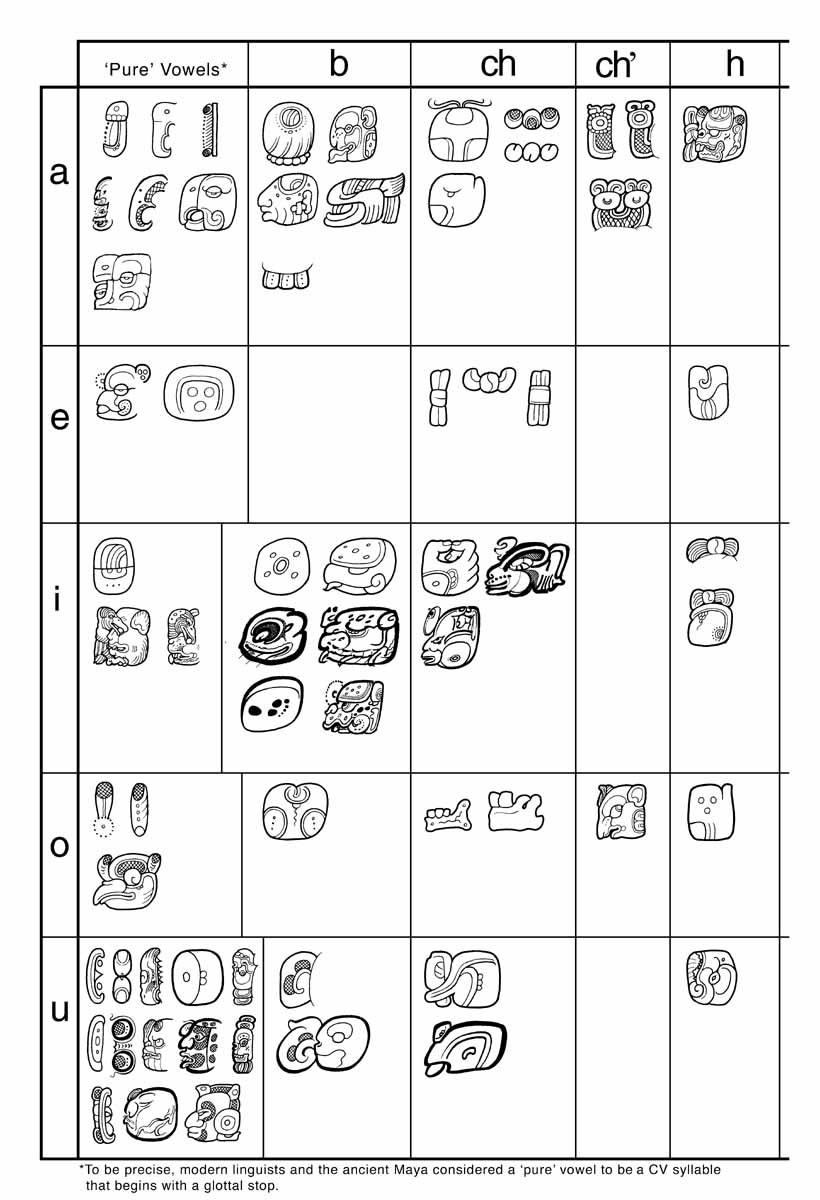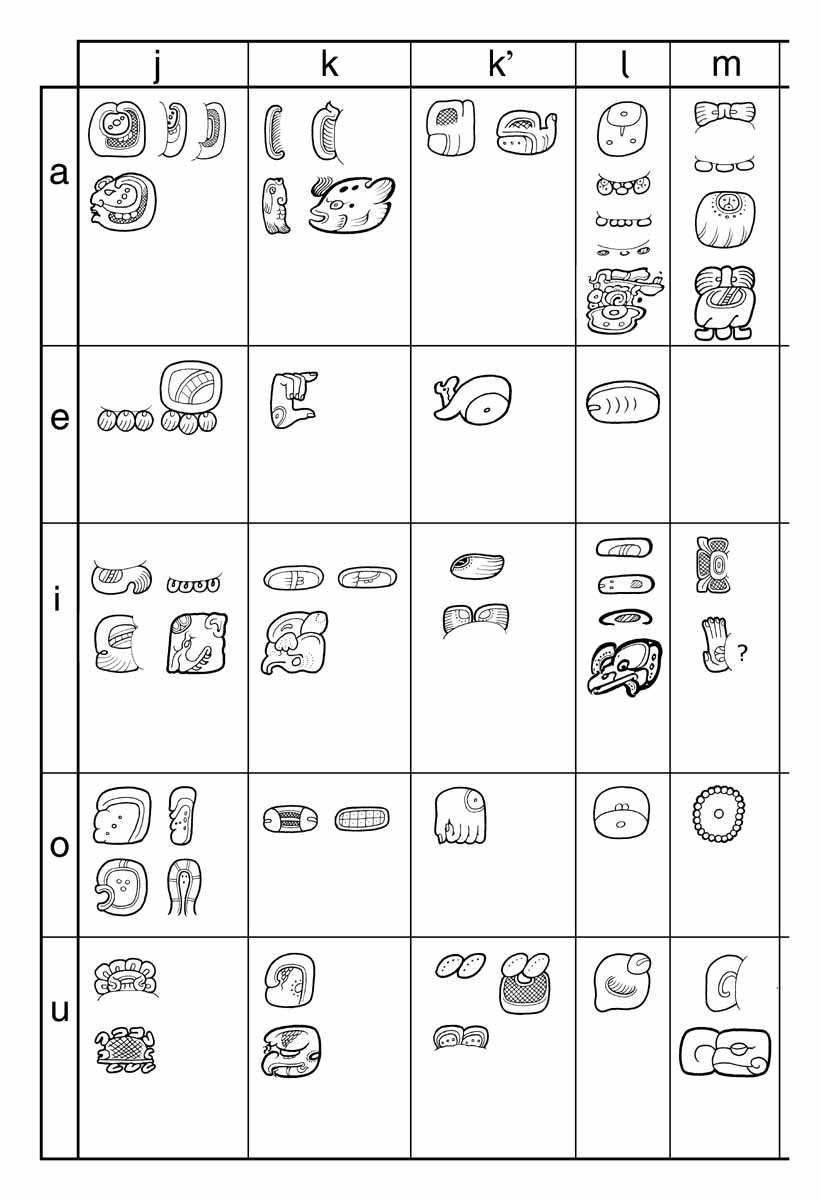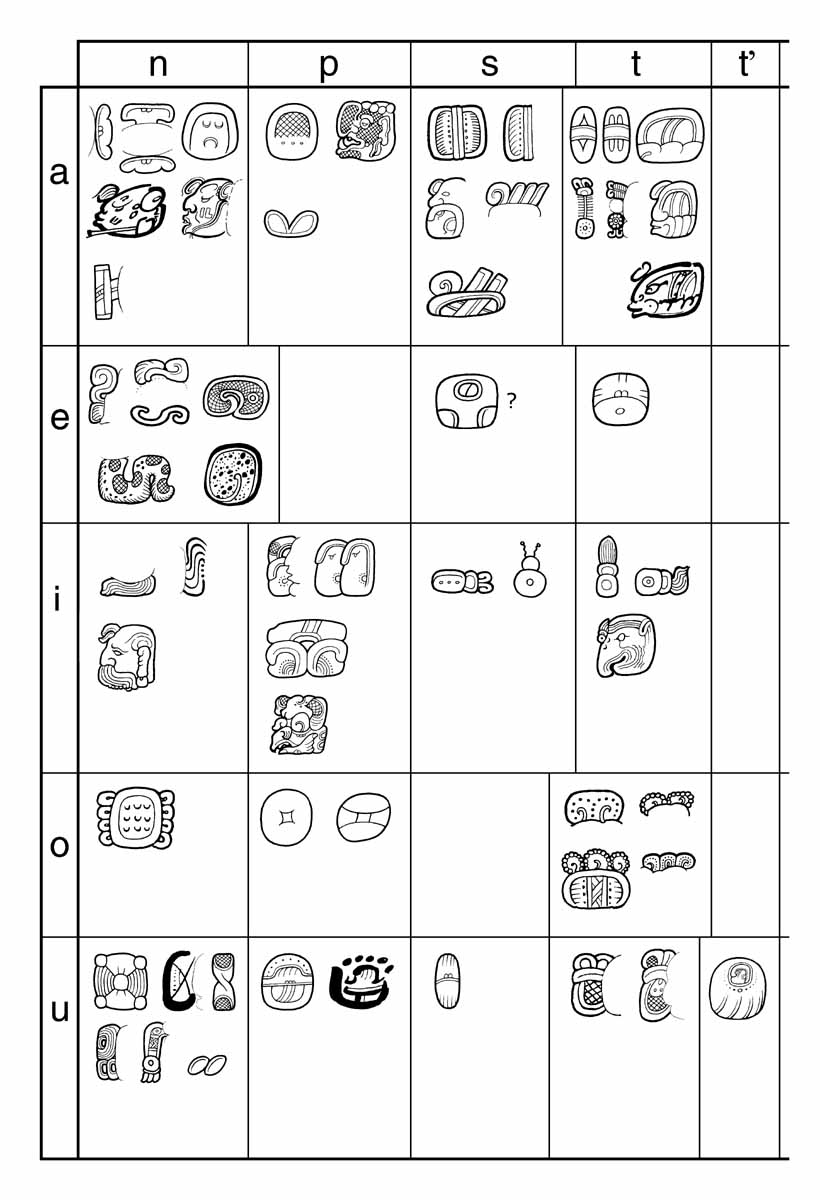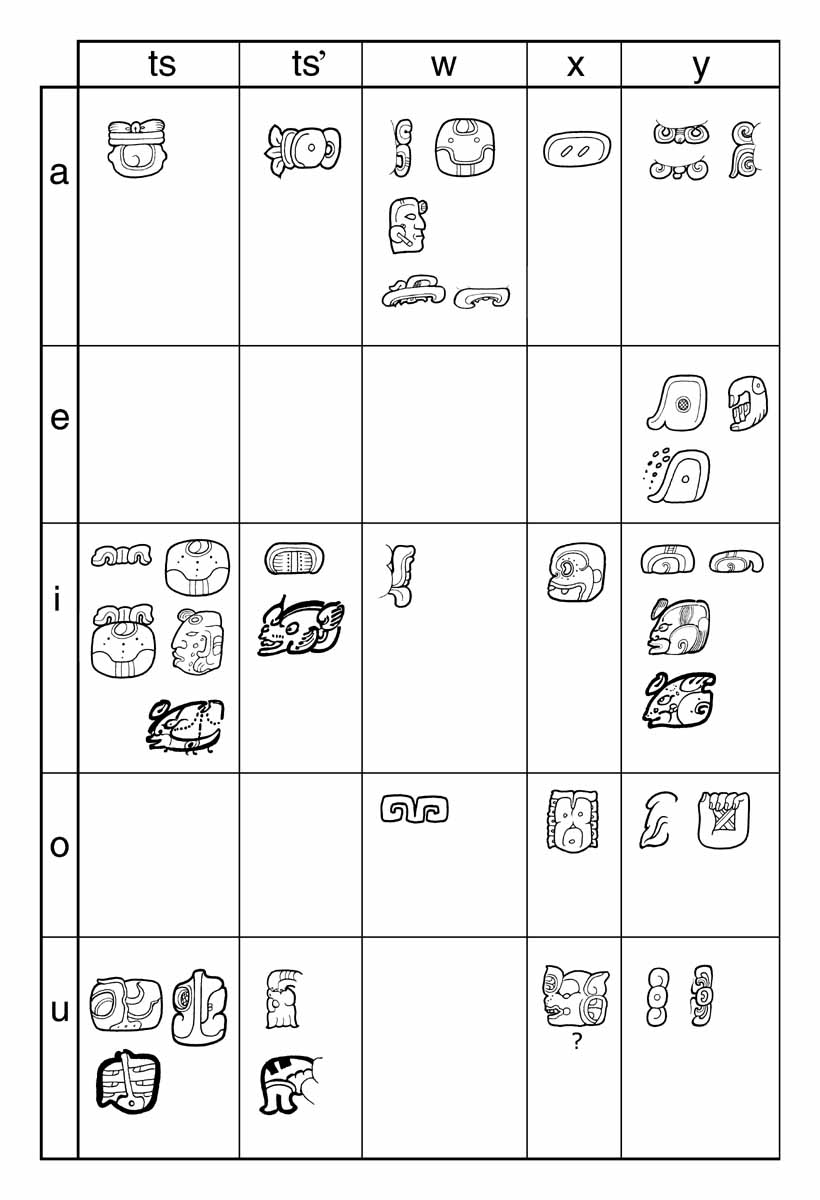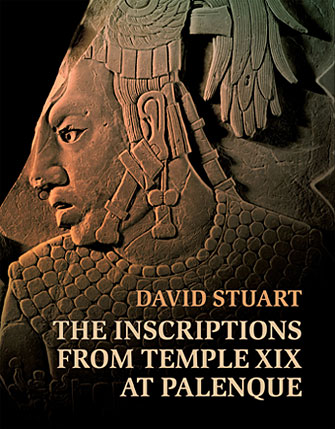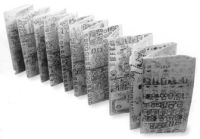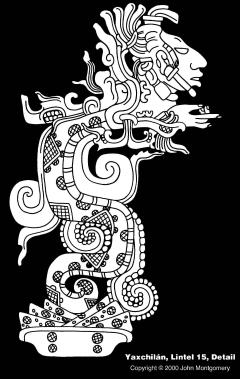
Maya Glyph Blog 2010, No. 2: Xcalumkin - The Preliminary Xcalumkin (Campeche, Mexico) Maya Syllabary
The second installment of Maya Glyph Blog presents the Preliminary Xcalumkin Maya Syllabary. For introductory remarks on syllabaries, see Maya Glyph Blog 2010, No. 1.
The hieroglyphic texts at Xcalumkin were all carved in stone and were composed between A.D. 724 (Lintel 2) and A.D. 751-771 (Column 1). This is at present the range of dates at the site, which since the 1960's has been heavily looted. Other dated inscriptions, or any other hieroglyphic text for that matter, may have been looted in the past before the presently known corpus was established and published.
Hieroglyphic texts are distributed among two major architectural groups at Xcalumkin, namely the Hieroglyphic Group and the Initial Series Group.
The syllabary for Xcalumkin is not completely filled in. This is due to the fact that the local corpus is limited and that most texts are relatively short with a limited subject matter (the majority of texts record highly repetitive dedicatory texts in which relatively few substitutions take place). The Preliminary Xcalumkin Maya Syllabary has been prepared by digitally cutting and pasting single glyph signs from the black-and-white line drawings of the inscriptions prepared by Eric Von Euw and Ian Graham (1992, "Corpus of Maya Hieroglyphic Inscriptions, Volume 4, Part 3: Uxmal, Xcalumkin", Peabody Museum of Archaeology and Ethnology, Cambridge, MA).
This syllabary follows the lay-out of the other syllabaries (see Coe & Van Stone [CVS], Chichen Itza [CHN]) and consists of four parts. Each of the four parts of this syllabary is accompanied by an annotated list of the Classic Maya epigraphic syllable inventory. As with the Chichen Itza syllabary, I present these preliminary notes to assist in the identification of all syllabic signs included in the Xcalumkin syllabic grid.
Abbreviations used
CHN = Chichen Itza
CVS = Coe & Van Stone (referring to the syllabary)
T+number = refers to a sign from the 1962 Thompson catalog
XLM = Xcalumkin
The second installment of Maya Glyph Blog presents the Preliminary Xcalumkin Maya Syllabary. For introductory remarks on syllabaries, see Maya Glyph Blog 2010, No. 1.
The hieroglyphic texts at Xcalumkin were all carved in stone and were composed between A.D. 724 (Lintel 2) and A.D. 751-771 (Column 1). This is at present the range of dates at the site, which since the 1960's has been heavily looted. Other dated inscriptions, or any other hieroglyphic text for that matter, may have been looted in the past before the presently known corpus was established and published.
Hieroglyphic texts are distributed among two major architectural groups at Xcalumkin, namely the Hieroglyphic Group and the Initial Series Group.
The syllabary for Xcalumkin is not completely filled in. This is due to the fact that the local corpus is limited and that most texts are relatively short with a limited subject matter (the majority of texts record highly repetitive dedicatory texts in which relatively few substitutions take place). The Preliminary Xcalumkin Maya Syllabary has been prepared by digitally cutting and pasting single glyph signs from the black-and-white line drawings of the inscriptions prepared by Eric Von Euw and Ian Graham (1992, "Corpus of Maya Hieroglyphic Inscriptions, Volume 4, Part 3: Uxmal, Xcalumkin", Peabody Museum of Archaeology and Ethnology, Cambridge, MA).
This syllabary follows the lay-out of the other syllabaries (see Coe & Van Stone [CVS], Chichen Itza [CHN]) and consists of four parts. Each of the four parts of this syllabary is accompanied by an annotated list of the Classic Maya epigraphic syllable inventory. As with the Chichen Itza syllabary, I present these preliminary notes to assist in the identification of all syllabic signs included in the Xcalumkin syllabic grid.
Abbreviations used
CHN = Chichen Itza
CVS = Coe & Van Stone (referring to the syllabary)
T+number = refers to a sign from the 1962 Thompson catalog
XLM = Xcalumkin
 The Preliminary Xcalumkin Maya Syllabary, Part 1: 'a-hu
The Preliminary Xcalumkin Maya Syllabary, Part 1: 'a-huNB: I prefer to open the "vowel signs" with a glottal stop, /'/ (in contrast to some epigraphers and the original Coe & Van Stone syllabary)
'a - All four signs are graphic variations of T228. Most common are 'a1 and 'a2, when the syllabic sign 'a is found in initial position; 'a3 and 'a4 are recorded as such when the 'a syllabic sign is found in final position. Complete horizontal inversion or rotation of the sign (compare 'a1-'a2 to 'a3 to 'a4) does not change the value of the sign
'e - Two graphic variations for the syllabic sign 'e. At Xcalumkin only the zoomorphic variant of 'e is recorded; the sign seems to represent the head of a toad-or iguana-like creature. While 'e1 is a bit eroded, it is clearly zoomorphic; 'e2, however, has some anthropomorphic characteristics
(The following is very tentative: 'e1 and 'e2 are employed in the spelling ki-ti pa-'a 'e1/'e2-ka-tzi, a nominal/titular phrase which also can be found recorded as ki-ti pa-'a 'i-ka-tzi, and which would generate glosses as kit pa' eka[a]tz and kit pa' ika[a]tz [see my 2009 vocabulary]. What if indeed this is an iguana? Several Western Mayan languages, like Tzotzil and Tzeltal, have initab/initam as "iguana"; could thus the animal head sign, if indeed an iguana head, be syllabic 'i instead of 'e? If so, all these examples would be straightforward kit pa' ika[a]tz. In another context at Xcalumkin, this would either generate 'IX BAK-'e-le or 'IX BAK-'i-le. As written, this is very tentative and needs more research)
'i - Two variants for the common syllabic sign for 'i, T679; the difference is due to the carving technique of the individual artists (here it can be seen that drawings are but an approximation of the original carving style; one needs to be familiar with the drawing conventions to identify the particular carving style. For photographs of these monuments, see Van Euw and Graham 1992. Thompson's T679d is based on an example at Xcalumkin)
'o - No text at Xcalumkin has yet been identified that includes a sign for 'o. The ceramic vessel cataloged as Kerr No. 8017 (which forms part of the collection of the Kimbell Art Museum, Fort Worth, TX) has been assigned to Xcalumkin, based on style and contents of its hieroglyphic texts. But this vessel comes from a looted context and as such its exact provenience is unknown. This vessel does record a syllabic sign for 'o in a compound ko-'o-ka-ba/BAH (T757 is employed, a sign which started as a logograph BAH, but which towards the end of the Classic period acrophonically it was reduced to simply ba. In the present example it was most probably employed as syllabic ba, but without another spelling example of this compound, providing a substitution for T757, this is only conjecture)
'u - I have illustrated five signs for 'u; these five signs represent three allographs. 'u1 and 'u3 represent one allograph (T1, T3), 'u2 and 'u5 present a second variant (T513), while 'u4 is unique to Xcalumkin. It seems to be a variant version of a jewel or bead on a belt assemblage or necklace (compare to T232 and CHN 'u7)
ba - ba1 to ba5 are all graphic variations of T501 ba. The differences in the outer appearance of each variant is due to the individual carver and the carving technique or style employed. ba5 is T655
be - No text at Xcalumkin has yet been identified that includes a sign for be
bi - At Xcalumkin only the abstract sign T585 bi has been employed
bo - Two graphic variations for bo, T693
bu - There is only one occurrence of the syllabic sign bu, in the collocation 9-TZ'AK-bu (XLM Misc. 5: B). Normally scribes and sculptors employed individual circular elements on the inner scroll, but this sculptor chose a row of small circles to distinguish the bu sign from mu (compare MVS bu1 to MVS mu1)
cha - No text at Xcalumkin has yet been identified that includes a sign for cha
che - This sign occurs only once in the extant corpus at Xcalumkin, in a collocation [yo]to-che (Column 4: A3) for yoto[o]ch "his/the house (in the sense of home)." The noun oto[o]ch is in the Yucatecan language and is in contrast with common Epigraphic Maya noun oto[o]t, which is in the Ch'olan language. As such the vernacular language was recorded, a precursor to present-day Yucatecan Maya (or perhaps Campechean Maya), which took precedent over the established prestige language used in recording Maya hieroglyphic texts (a language which may have been based in the Eastern Ch'olan language group and probably was pre-Ch'oli'an in origin) (see Houston, Robertson, and Stuart, 2000, "The Language of Classic Maya Inscriptions," in Current Anthropology 41 (3): 321–356 & Lacadena and Wichmann, 2004, "On the Representation of the Glottal Stop in Maya Writing")
chi - No text at Xcalumkin has yet been identified that includes a sign for chi
cho - No text at Xcalumkin has yet been identified that includes a sign for cho
chu - No text at Xcalumkin has yet been identified that includes a sign for chu
ch'a - No text at Xcalumkin has yet been identified that includes a sign for ch'a
ch'e - No text at Xcalumkin or the Maya area in general has yet been identified that includes a sign for ch'e (but in 2006 Yuri Polyukhovich circulated a manuscript in which he tentatively identified a ch'e sign in a Tonina inscription; this proposal in under review)
ch'i - No text at Chichen Itza or the Maya area in general has yet been identified that includes a sign for ch'i (but I should note that some epigraphers are considering T77 [T72, T76, T81] and variants, a possible k'i syllable, as a ch'i syllable)
ch'o - This is the graphic variation at Xcalumkin for ch'o (compare to T758a, see MVS ch'o). The syllable ch'o is derived acrophonically from the noun ch'o'h~ch'o' "rat"
ch'u - No text at Xcalumkin or the Maya area in general has yet been identified that includes a sign for ch'u
ha - No text at Xcalumkin has yet been identified that includes a sign for ha
he - No text at Xcalumkin has yet been identified that includes a sign for he
hi - hi1 and hi2 are variations of the same sign, the visible (non-obstructed or non-overlapped) part of a full sign for hi, namely the digraph T145e:528 hi. hi3 seems to be the singular representation of just the knot element of the digraph T145e:528, rotated 90 degrees and it occurs in the context 'AJ-pa sa-hi-na (XLM Lintel 1), which on Kerr No. 8017 can be found written 'AJ-pa sa-hi-na (with variants for 'AJ, pa, sa, and na, and with a most clear sign for hi)
ho - No text at Xcalumkin has yet been identified that includes a sign for ho (see MVS ho)
hu - No text at Xcalumkin has yet been identified that includes a sign for hu (see MVS hu)
 The Preliminary Xcalumkin Maya Syllabary, Part 2: ja-mu
The Preliminary Xcalumkin Maya Syllabary, Part 2: ja-muja - At Xcalumkin the T683b "full moon" sign is represented in ja3 and ja4. Interestingly, the "full moon" does not need to be open at the top side and either two or three dots can occupy the space in the "moon crescent." ja1 is the reduced sign, due to overlap. However, as ja2 indicates, the "reduced sign due to overlap" became an independent sign. ja2 is separated fully from the sign that preceded it (Column 1: A5)
je - This is the local variant of the common T69 (only lower suffix!) je sign
ji - There is some nice variation in the signs for ji. ji1 and ji2 only differ in 180 degrees of rotation (ji2 is superfixed in a collocation 'AJ-ji-pu); each of these variations employs three u-shaped elements. ji3, however, employs five u-shaped elements (see notes to CHN ji)
jo - Two variations for jo. jo1 is a most abstract representation with the "opening" on the right side. jo2 is a more elaborate version, with the opening on the left side (compare to the CHN jo signs plus notes)
ju - These two sign identifications are tentative. ju1 seems to be a good representation of the digraph that depicts a turtle carapace encircled by u-shaped elements (see CVS ju1, but more appropiately see CHN ju1). ju2 seems to be an abbreviated version, with much less u-shaped elements (Cornice 1, Stone VII: A). Compare this reduction of the u-shaped elements to CHN ju2
ka - ka1 is the actual T738b "fish" sign for ka (based on kay "fish," acrophonically reduced to ka); ka2 and ka3 are graphic variants of the "fish fin" reduction or abbreviation of the "full" ka sign (through pars pro toto, "part that represents the whole")
ke - The identification of this hand sign at Xcalumkin as ke is tentative. In contrast to the regular ke signs, this hand seems to contain some kind of round object (compare CVS ke, but actually this is the incorrect hand sign, it should have the thumb on the left side; see Boot, 2003, "The Human Hand in Classic Maya Hieroglyphic Writing," p. 5; recently, Nikolai Grube has shown that the "hand plus monkey" is a fixed sign group and which, in its entirety, has the logographic value KELEM)
ki - ki1 is the full form (the head of a bird with a very distinctive eye element) of this particular ki sign, of which ki3 (rotated 180 degrees) is, tentatively, the reduced form through a process of pars pro toto (just the "eye" element remains; compare to the possible origin of T582 mo [compare CVS mo], the eye of the macaw bird, mo'~mo'o'). ki2 is a variation of ki3 by a different hand
ko - Two local variations of the common T110 ko sign
ku - No text at Xcalumkin has yet been identified that includes a sign for ku. On Kerr No. 8017 a syllabic sign ku can be found in a compound spelling 'AJ-lu-ku for aj luk, a title of some sort (aj "male or general agentive prefix," luk [or abbreviated spelling for lukul?, lukum?] a noun [meaning in this context to be determined]) (dedicatory text along the upper rim, at position N)
k'a - Two local variations, in different scribal/sculptural hands, of the common T669 k'a sign; both k'a1 and k'a2 are variations of T669b
k'e - No text at Xcalumkin has yet been identified that includes a sign for k'e
k'i - T72 is Thompson's catalog rendering (but drawn by Avis Tulloch) of this exact example as employed at Xcalumkin. The sign depicts two wings (reduced to one wing, cataloged as T76, T77, T81) and David Stuart suggested in 2002 that the sign may be based on *k'iy "spread out (wings)" and thus, if correct, k'i was derived acrophonically from *k'iy. Stuart introduced various early examples of the "spread out wings" sign; the example at Xcalumkin is of Late Classic manufacture and the sculptor may have introduced an Early Classic convention to employ this sign. That said, this sign only occurs once in the local corpus (XLM Column 1: A4) and the collocation in which it occurs ('AJ-T72-mi-la-yu) may hint at a non-syllabic employment (T72, T76, T77, T81 as K'A'?) (compare Boot 1995, "Notes on the Inscriptions of Xcalumkin, Campeche, Mexico", in Yumtzilob Vol. 8, No. 2). If future research does provide evidence that this sign is employed as a logograph in this particular context, it will be removed from the preliminary syllabary
k'o - No text at Xcalumkin has yet been identified that includes a sign for k'o
k'u - No text at Xcalumkin has yet been identified that includes a sign for k'u
la - In this Xcalumkin syllabary, I present 6 signs for la. la1, la2, and la3 are graphic variations, in which the sculptors chose to provide less inner detail, but in which the most diagnostic aspects were retained, namely the facial features of an inverted face with a mouth and two eyes. la4 is just one single element of la1, in Thompson's catalog entered as T534 (and as an affix, the first four variations of T178). I have not yet explored the complete evolution of this sign, but possibly T534 originated first and la1, la2, and la3 were derived from T534 by duplication (for some insight into the formal evolution of T139 and T178, see Lacadena, 1995, "Evolución formal de las grafías escriturarias mayas: Implicaciones históricas y culturales," pp. 229-245). T534 is a sign, the graphic origin of which seems to lie in a 180 degrees rotation of T533 'AJAW. Rotation can thus be of great importance in establishing the correct value of a sign. la5 and la6 have a different graphic origin; the signs contain (a) T-shaped element(s) and three stacked circular elements. These la signs (note graphic variations) were cataloged by Thompson as T139, T254, and T534 (bottom sign only!) (see CHN la6 and la7)
le - le1 and le4 are variations of the same sign, an elongated sign with small c-shaped incisions. le2 is another variation, in which the c-shaped elements are reduced to just three within an oblong cartouche. le3 is a variation of this sign; the small elements are retained, but the cartouche has been eliminated. There is some debate among epigraphers if these signs are indeed le (as the sign is different from T188, the common sign for le), or possibly local variants of li; although tentative, the example 'u-wo-jo-le-li/'u-wo-jo-li-le on XLM Capital 5: B seems to provide evidence that these are distinct signs (employing XLM le3 and XLM li1; note spelling yu-xu-?-li4-le4 on XLM Lintel 2: E-F)
li - li1 and li3 are the most commonly employed signs for li at Xcalumkin. li2 is a tentative identification, it looks like the sign contains multiple small compartments in a row (like li1 and li3 have two). The multiple "compartments" clearly distinguish it from the le signs with their multiple c-shaped elements (with the opening on the left or on the right side). It can be found in the compound yu-xu-lu-li2 on XLM Column 1 (at A2). li4 is the local variation of the "worm bird" sign for li (MVS li4)
lo - No text at Xcalumkin has yet been identified that includes a sign for lo
lu - Three local variations of the common T568c sign for lu. lu3 is T654, as cataloged by Thompson
ma - ma1 is the complete, multi-graphic sign for ma, as first identified by David Stuart. This sign, due to overlap, can be reduced to just the top part (ma2, ma3) or the bottom part (ma4)
me - No text at Xcalumkin has yet been identified that includes a sign for me
mi - Occurring only once in the extant corpus at Xcalumkin, this is the sign for mi (T179, which was deciphered by Nikolai Grube)
mo - No text at Xcalumkin has yet been identified that includes a sign for mo
mu - This is the drawing of a very eroded sign for mu, to my knowledge identified first by David Stuart. Although I generally do not include signs at such a high level of erosion, it shows that mu was employed (in a collocation mu-ti on XLM Lintel 3, front, at position B; the published photograph shows conclusive detail, Ian Graham was conservative in his rendering of the sign)
 The Preliminary Xcalumkin Maya Syllabary, Part 3: na-t'u
The Preliminary Xcalumkin Maya Syllabary, Part 3: na-t'una - na1, na2, and na3 are local graphic variations of the common T23 na sign. Local sculptors, however, detached the two or three circular elements from the inner line to show some kind of diagonal (most clearly in na3). na4 is a human face, containing several rows of those circular elements (unique example at Xcalumkin, to be found in XLM Panel 2: A9b, HUN-na)
ne - No text at Xcalumkin has yet been identified that includes a sign for ne
ni - Three graphic variations of the sign T116 ni, in which ni1 is the most reduced or abstract and ni2 and ni3 are the most elaborate
no - No text at Xcalumkin has yet been identified that includes a sign for no
nu - No text at Xcalumkin has yet been identified that includes a sign for nu
pa - Three graphic variations of the common T586 pa sign; the small inner elements in pa1 and pa3 are unique to the local style at Xcalumkin
pe - No text at Xcalumkin has yet been identified that includes a sign for pe
pi - No text at Xcalumkin has yet been identified that includes a sign for pi
po - No text at Xcalumkin has yet been identified that includes a sign for po
pu - The local variant of pu
p'a - No text at Xcalumkin (or the Maya area in general) has yet been identified that includes a sign for p'a
p'e - No text at Xcalumkin (or the Maya area in general) has yet been identified that includes a sign for p'e
p'i - No text at Xcalumkin (or the Maya area in general) has yet been identified that includes a sign for p'i
p'o - No text at Xcalumkin (or the Maya area in general) has yet been identified that includes a sign for p'o
p'u - No text at Xcalumkin (or the Maya area in general) has yet been identified that includes a sign for p'u
sa - sa1 and sa2 are two variations of the full version of sa. sa3 and sa4 are abbreviated versions, due to overlap. Note that the central part in sa3 and sa4 has been replaced by zigzag lines, a scribal variation that does not alter the value of the sign
se - No text at Xcalumkin has yet been identified that includes a sign for se
si - No text at Xcalumkin has yet been identified that includes a sign for si
so - No text at Xcalumkin has yet been identified that includes a sign for so
su - No text at Xcalumkin has yet been identified that includes a sign for su
ta - ta1 and ta2 are the local variants of the common sign T565 ta. ta3 has not survived in its complete form due to erosion, but it is a local variant of T103 ta/MVS ta1 (occurring in the collocation PET?-ta3-ja in XLM Lintel 1: B)
te - No text at Xcalumkin has yet been identified that includes a sign for te
ti - Three local variations of T59 ti; rotation has no influence on the value of this sign
to - Local variant of MVS to1, to2, and to4 (MVS to3 is the full, unabbreviated, non-overlapped form, a digraph T45var:563b)
tu - Local variants of T89/T90 tu
t'a - No text at Xcalumkin has yet been identified that includes a sign for t'a
t'e - No text at Xcalumkin (or the Maya area in general) has yet been identified that includes a sign for t'e
t'i - No text at Xcalumkin (or the Maya area in general) has yet been identified that includes a sign for t'i
t'o - No text at Xcalumkin has yet been identified that includes a sign for t'o
t'u - No text at Xcalumkin has yet been identified that includes a sign for [T528]501 t'u
 The Preliminary Xcalumkin Maya Syllabary, Part 4: tza-yu
The Preliminary Xcalumkin Maya Syllabary, Part 4: tza-yutza - Two graphic variations of the sign for tza, deciphered first by David Stuart
tze - No text at Xcalumkin has yet been identified that includes a sign for tze
tzi - Two local variations of the common sign T507 for tzi (see Stuart, 1989, "Ten Phonetic Syllables")
tzo - No text at Xcalumkin has yet been identified that includes a sign for tzo
tzu - No text at Xcalumkin has yet been identified that includes a sign for tzu
tz'a - Local variations of the common sign for tz'a, deciphered first by Nikolai Grube (1990, "Die Errichtung von Stelen: Entzifferung einer Verbhieroglyphe auf Monumenten der klassischen Mayakultur"); the small, infixed element is not included due to overlap in these examples (by the syllabic sign 'i, in collocations spelling ['i]tz'a-ti) (compare MVS tz'a)
tz'e - No text at Xcalumkin has yet been identified that includes a sign for tz'e
tz'i - tz'i1 and tz'i2 are graphic variations of the well-known sign T248 tz'i, in its main sign form cataloged by Thompson as T563a
tz'o - No text at Xcalumkin has yet been identified that includes a sign for tz'o
tz'u - No text at Xcalumkin has yet been identified that includes a sign for tz'u. Kerr No. 8017 does contain a compound which includes a syllabic sign for tz'u (dedicatory text along the upper rim, at position F: 'a-ma-tz'u, possibly targeting a title a[j] ma[a]tz', aj "male or general agentive prefix," ma[a]tz' "corn gruel")
wa - Two graphic variations of the common sign for wa, T130
we - No text at Xcalumkin (or in the Maya area in general) has yet been identified that includes a syllabic sign for we
wi - Three graphic variations of the common sign for wi, T117. Especially wi2 and wi3 are more abstract and squared
wo - wo1 is the more fluent version of T67 wo. Note that wo2 is the actual sign on which one of the drawings included in Thompson's catalog is based
wu - No text at Xcalumkin (or in the Maya area in general) has yet been identified that includes a sign for wu (but a sign graphically close to T285 and most commonly employed as superfix may be a candidate for either wu or hu in collocations as wu?/hu?-EYE)
xa - No text at Xcalumkin has yet been identified that includes a sign for xa
xe - No text at Xcalumkin has yet been identified that includes a sign for xe
xi - No text at Xcalumkin has yet been identified that includes a sign for xi
xo - No text at Xcalumkin has yet been identified that includes a sign for xo
xu - Two graphic variations of T756a-b, possibly employed as the syllabic sign xu (still under review, as such the query; see Boot 2009, "The Bat Sign in Maya Hieroglyphic Writing: Some Notes and Suggestions, Based on Examples on Late Classic Ceramics," available at Mayavase.com)
ya - Four graphic variations for ya. Rotation does not alter the value of this sign, nor do the amount or arrangement of the small circular elements between the two larger u-shaped elements
ye - No text at Xcalumkin has yet been identified that includes a sign for ye
yi - This sign may be a local variation of yi, but as can be seen in the drawing, it is partially eroded. As such the identification is tentative (it occurs only once, and at present the context does not help in establishing its value, XLM Column 2: B2, tu-wi-yi?-bi-?). On Kerr No. 8017 a clear yi syllabic sign can be found in the spelling 'u-ja-yi
yo - Employed only once, the local variant of T673 yo (in this case the clenched hand is produced with the right hand) (compare CHN yo1 and yo2)
yu - yu1 is the local variation of the common sign T61 yu. yu2, yu3, and yu4 are scribal variations typical to Xcalumkin
First edit: July 15, 2010. Last edits: July 25, 2010 & August 21, 2010

